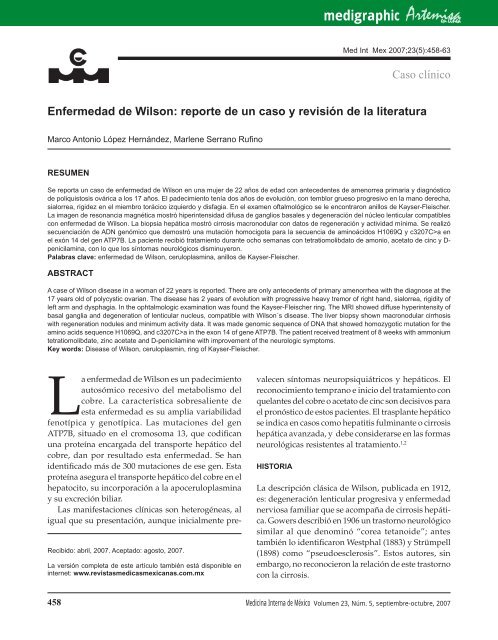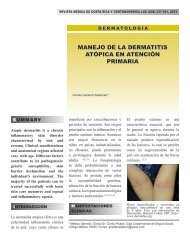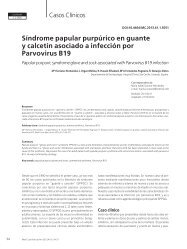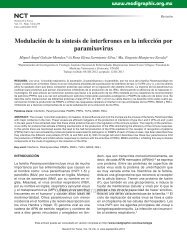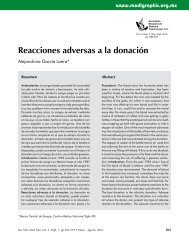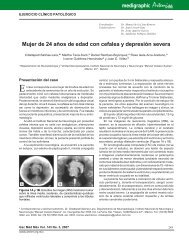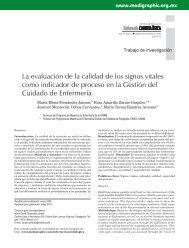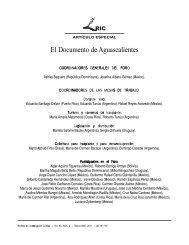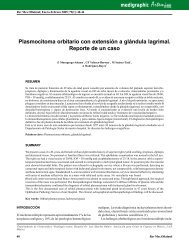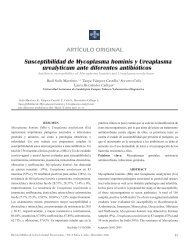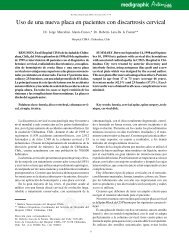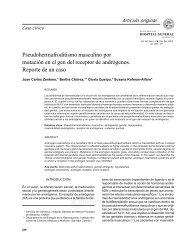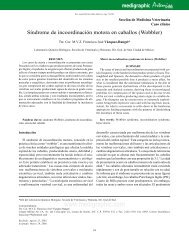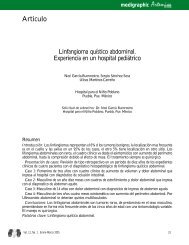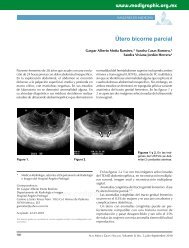Enfermedad de Wilson: reporte de un caso y revisión de la literatura
Enfermedad de Wilson: reporte de un caso y revisión de la literatura
Enfermedad de Wilson: reporte de un caso y revisión de la literatura
Create successful ePaper yourself
Turn your PDF publications into a flip-book with our unique Google optimized e-Paper software.
medigraphic<br />
Artemisa<br />
en línea<br />
Med Int Mex 2007;23(5):458-63<br />
Caso clínico<br />
<strong>Enfermedad</strong> <strong>de</strong> <strong>Wilson</strong>: <strong>reporte</strong> <strong>de</strong> <strong>un</strong> <strong>caso</strong> y <strong>revisión</strong> <strong>de</strong> <strong>la</strong> <strong>literatura</strong><br />
Marco Antonio López Hernán<strong>de</strong>z, Marlene Serrano Rufino<br />
RESUMEN<br />
Se reporta <strong>un</strong> <strong>caso</strong> <strong>de</strong> enfermedad <strong>de</strong> <strong>Wilson</strong> en <strong>un</strong>a mujer <strong>de</strong> 22 años <strong>de</strong> edad con antece<strong>de</strong>ntes <strong>de</strong> amenorrea primaria y diagnóstico<br />
<strong>de</strong> poliquistosis ovárica a los 17 años. El pa<strong>de</strong>cimiento tenía dos años <strong>de</strong> evolución, con temblor grueso progresivo en <strong>la</strong> mano <strong>de</strong>recha,<br />
sialorrea, rigi<strong>de</strong>z en el miembro torácico izquierdo y disfagia. En el examen oftalmológico se le encontraron anillos <strong>de</strong> Kayser-Fleischer.<br />
La imagen <strong>de</strong> resonancia magnética mostró hiperintensidad difusa <strong>de</strong> ganglios basales y <strong>de</strong>generación <strong>de</strong>l núcleo lenticu<strong>la</strong>r compatibles<br />
con enfermedad <strong>de</strong> <strong>Wilson</strong>. La biopsia hepática mostró cirrosis macronodu<strong>la</strong>r con datos <strong>de</strong> regeneración y actividad mínima. Se realizó<br />
secuenciación <strong>de</strong> ADN genómico que <strong>de</strong>mostró <strong>un</strong>a mutación homocigota para <strong>la</strong> secuencia <strong>de</strong> aminoácidos H1069Q y c3207C>a en<br />
el exón 14 <strong>de</strong>l gen ATP7B. La paciente recibió tratamiento durante ocho semanas con tetratiomolibdato <strong>de</strong> amonio, acetato <strong>de</strong> cinc y D-<br />
penici<strong>la</strong>mina, con lo que los síntomas neurológicos disminuyeron.<br />
Pa<strong>la</strong>bras c<strong>la</strong>ve: enfermedad <strong>de</strong> <strong>Wilson</strong>, cerulop<strong>la</strong>smina, anillos <strong>de</strong> Kayser-Fleischer.<br />
ABSTRACT<br />
A case of <strong>Wilson</strong> disease in a woman of 22 years is <strong>reporte</strong>d. There are only antece<strong>de</strong>nts of primary amenorrhea with the diagnose at the<br />
17 years old of polycystic ovarian. The disease has 2 years of evolution with progressive heavy tremor of right hand, sialorrea, rigidity of<br />
left arm and dysphagia. In the ophtalmologic examination was fo<strong>un</strong>d the Kayser-Fleischer ring. The MRI showed diffuse hyperintensity of<br />
basal ganglia and <strong>de</strong>generation of lenticu<strong>la</strong>r nucleus, compatible with <strong>Wilson</strong>´s disease. The liver biopsy shown macronodu<strong>la</strong>r cirrhosis<br />
with regeneration nodules and minimum activity data. It was ma<strong>de</strong> genomic sequence of DNA that showed homozygotic mutation for the<br />
amino acids sequence H1069Q, and c3207C>a in the exon 14 of gene ATP7B. The patient received treatment of 8 weeks with ammonium<br />
tetratiomolibdate, zinc acetate and D-penici<strong>la</strong>mine with improvement of the neurologic symptoms.<br />
Key words: Disease of <strong>Wilson</strong>, cerulop<strong>la</strong>smin, ring of Kayser-Fleischer.<br />
Recibido: abril, 2007. Aceptado: agosto, 2007.<br />
La versión completa <strong>de</strong> este artículo también está disponible en<br />
internet: www.revistasmedicasmexicanas.com.mx<br />
La enfermedad <strong>de</strong> <strong>Wilson</strong> es <strong>un</strong> pa<strong>de</strong>cimiento<br />
autosómico recesivo <strong>de</strong>l metabolismo <strong>de</strong>l<br />
cobre. La característica sobresaliente <strong>de</strong><br />
esta enfermedad es su amplia variabilidad<br />
fenotípica y genotípica. Las mutaciones <strong>de</strong>l gen<br />
ATP7B, situado en el cromosoma 13, que codifican<br />
<strong>un</strong>a proteína encargada <strong>de</strong>l transporte hepático <strong>de</strong>l<br />
cobre, dan por resultado esta enfermedad. Se han<br />
i<strong>de</strong>ntificado más <strong>de</strong> 300 mutaciones <strong>de</strong> ese gen. Esta<br />
proteína asegura el transporte hepático <strong>de</strong>l cobre en el<br />
hepatocito, su incorporación a <strong>la</strong> apocerulop<strong>la</strong>smina<br />
y su excreción biliar.<br />
Las manifestaciones clínicas son heterogéneas, al<br />
igual que su presentación, a<strong>un</strong>que inicialmente prevalecen<br />
síntomas neuropsiquiátricos y hepáticos. El<br />
reconocimiento temprano e inicio <strong>de</strong>l tratamiento con<br />
que<strong>la</strong>ntes <strong>de</strong>l cobre o acetato <strong>de</strong> cinc son <strong>de</strong>cisivos para<br />
el pronóstico <strong>de</strong> estos pacientes. El trasp<strong>la</strong>nte hepático<br />
se indica en <strong>caso</strong>s como hepatitis fulminante o cirrosis<br />
hepática avanzada, y <strong>de</strong>be consi<strong>de</strong>rarse en <strong>la</strong>s formas<br />
neurológicas resistentes al tratamiento. 1,2<br />
HISTORIA<br />
La <strong>de</strong>scripción clásica <strong>de</strong> <strong>Wilson</strong>, publicada en 1912,<br />
es: <strong>de</strong>generación lenticu<strong>la</strong>r progresiva y enfermedad<br />
nerviosa familiar que se acompaña <strong>de</strong> cirrosis hepática.<br />
Gowers <strong>de</strong>scribió en 1906 <strong>un</strong> trastorno neurológico<br />
simi<strong>la</strong>r al que <strong>de</strong>nominó “corea tetanoi<strong>de</strong>”; antes<br />
también lo i<strong>de</strong>ntificaron Westphal (1883) y Strümpell<br />
(1898) como “pseudoesclerosis”. Estos autores, sin<br />
embargo, no reconocieron <strong>la</strong> re<strong>la</strong>ción <strong>de</strong> este trastorno<br />
con <strong>la</strong> cirrosis.<br />
458 Medicina Interna <strong>de</strong> México Volumen 23, Núm. 5, septiembre-octubre, 2007
<strong>Enfermedad</strong> <strong>de</strong> <strong>Wilson</strong>: <strong>reporte</strong> <strong>de</strong> <strong>un</strong> <strong>caso</strong> y <strong>revisión</strong> <strong>de</strong> <strong>la</strong> <strong>literatura</strong><br />
Los estudios clínicos <strong>de</strong> Hall (1923) y Spielmeyer<br />
(1920), quienes examinaron <strong>de</strong> nuevo los cortes <strong>de</strong><br />
hígado y encéfalo <strong>de</strong> los <strong>caso</strong>s <strong>de</strong> Westphall y Strümpell,<br />
establecieron c<strong>la</strong>ramente que <strong>la</strong> pseudoesclerosis<br />
<strong>de</strong>scrita por estos últimos autores era <strong>la</strong> misma enfermedad<br />
<strong>de</strong>scrita por <strong>Wilson</strong>. L<strong>la</strong>ma <strong>la</strong> atención que<br />
ning<strong>un</strong>o <strong>de</strong> estos autores, incluso <strong>Wilson</strong>, observó<br />
el anillo corneal <strong>de</strong> color pardo dorado (<strong>de</strong> Kayser-<br />
Fleischer), signo patognomónico <strong>de</strong> <strong>la</strong> enfermedad. La<br />
anomalía corneal <strong>la</strong> <strong>de</strong>scribió por primera vez Kayser,<br />
en 1902, y al año siguiente Fleischer <strong>la</strong> re<strong>la</strong>cionó con<br />
<strong>la</strong> pseudoesclerosis.<br />
Rumpell había <strong>de</strong>mostrado el contenido enormemente<br />
aumentado <strong>de</strong> cobre en el hígado y en el<br />
encéfalo en 1913, pero este <strong>de</strong>scubrimiento se ignoró<br />
hasta que Man<strong>de</strong>lbrote (1948) encontró que <strong>la</strong> excreción<br />
urinaria <strong>de</strong>l cobre estaba aumentada en pacientes<br />
con enfermedad <strong>de</strong> <strong>Wilson</strong>. En 1952, Scheinberg y<br />
Gitlin <strong>de</strong>scubrieron que <strong>la</strong> cerulop<strong>la</strong>smina, enzima<br />
sérica que fija el cobre, está muy reducida en esta<br />
enfermedad. 3<br />
GENÉTICA Y EPIDEMIOLOGÍA<br />
Se trata <strong>de</strong> <strong>un</strong> pa<strong>de</strong>cimiento autosómico recesivo, que<br />
se localiza en el cromosoma 13 por mapeo <strong>de</strong>l gene<br />
13q14.3 11. Suele manifestarse entre los 3 y los 50 años<br />
<strong>de</strong> edad. Su frecuencia en <strong>la</strong> mayoría <strong>de</strong> <strong>la</strong>s pob<strong>la</strong>ciones<br />
es <strong>de</strong> casi 1:40,000 y <strong>la</strong> frecuencia <strong>de</strong> portadores<br />
<strong>de</strong> <strong>la</strong> mutación <strong>de</strong> ATP 7B es <strong>de</strong> aproximadamente<br />
1%. Según estos datos, el riesgo <strong>de</strong> pa<strong>de</strong>cer <strong>la</strong> enfermedad<br />
<strong>de</strong> <strong>Wilson</strong> en hijos <strong>de</strong> padres afectados es <strong>de</strong><br />
1 en 200. 7<br />
En <strong>un</strong> estudio efectuado con pob<strong>la</strong>ción francesa se<br />
i<strong>de</strong>ntificaron ocho nuevas mutaciones <strong>de</strong>l gen ATP7B<br />
asociadas con manifestaciones neurológicas tardías<br />
<strong>de</strong> <strong>la</strong> enfermedad <strong>de</strong> <strong>Wilson</strong>, lo que <strong>de</strong>mostró que<br />
los fenotipos re<strong>la</strong>cionados con mutaciones distintas<br />
que p.H1069Q son a menudo <strong>de</strong> manifestación más<br />
tardía. 8<br />
PRESENTACIÓN CLÍNICA Y DIAGNÓSTICO<br />
El cobre es <strong>un</strong> componente esencial <strong>de</strong> <strong>un</strong> número<br />
importante <strong>de</strong> reacciones enzimáticas para f<strong>un</strong>ciones<br />
básicas. Cuando el transporte <strong>de</strong> cobre se interrumpe<br />
se originan dos enfermeda<strong>de</strong>s en los humanos: <strong>la</strong> <strong>de</strong><br />
<strong>Wilson</strong> y <strong>la</strong> <strong>de</strong> Menkes; en ambas existen <strong>de</strong>fectos<br />
en <strong>la</strong>s proteínas <strong>de</strong> membrana transportadoras <strong>de</strong>l<br />
cobre. 4,5<br />
En <strong>un</strong> estudio <strong>de</strong> cohorte efectuado con 163 pacientes,<br />
Merle y co<strong>la</strong>boradores no hal<strong>la</strong>ron diferencia<br />
significativa en los parámetros clínicos o en <strong>la</strong> manifestación<br />
inicial <strong>de</strong> <strong>la</strong> enfermedad en los pacientes,<br />
agrupados <strong>de</strong> acuerdo con su mutación. Concluyeron<br />
que los pacientes con enfermedad <strong>de</strong> <strong>Wilson</strong>, con síntomas<br />
neuropsiquiátricos, tienen <strong>un</strong> diagnóstico más<br />
tardío y <strong>un</strong> pronóstico más <strong>de</strong>sfavorable que aquellos<br />
con presentación hepática. 7<br />
Los síntomas iniciales pue<strong>de</strong>n ser hepáticos,<br />
neurológicos o psiquiátricos. Las manifestaciones neurológicas<br />
y hepáticas ocurren, aproximadamente, con<br />
igual frecuencia. La enfermedad pue<strong>de</strong> manifestarse<br />
como crónica o fulminante <strong>de</strong>l hígado. La forma neurológica<br />
tien<strong>de</strong> a ocurrir en <strong>la</strong> seg<strong>un</strong>da y tercera décadas<br />
<strong>de</strong> <strong>la</strong> vida, pero también se ha reportado en niños. Las<br />
manifestaciones neurológicas incluyen alteraciones<br />
<strong>de</strong>l movimiento, como: tremor, pobre coordinación,<br />
rigi<strong>de</strong>z, pérdida <strong>de</strong>l control motor fino, disartria y<br />
dificulta<strong>de</strong>s para <strong>la</strong> <strong>de</strong>glución. Cerca <strong>de</strong> 20% <strong>de</strong> los<br />
pacientes pue<strong>de</strong>n tener síntomas psiquiátricos, sin<br />
otros síntomas clínicos. Se han reportado: <strong>de</strong>presión,<br />
comportamiento anormal e incluso esquizofrenia. 9,10<br />
El anillo <strong>de</strong> Kayser-Fleischer, en el limbo <strong>de</strong> <strong>la</strong> córnea,<br />
resulta <strong>de</strong>l <strong>de</strong>pósito <strong>de</strong> cobre en <strong>la</strong> membrana <strong>de</strong><br />
Descement; éste pue<strong>de</strong> estar ausente en más <strong>de</strong> 40%<br />
<strong>de</strong> los pacientes con afectación hepática, a<strong>un</strong>que suele<br />
haberlo en pacientes con manifestaciones neurológicas<br />
y psiquiátricas. 10<br />
Un rasgo característico <strong>de</strong> <strong>la</strong> enfermedad <strong>de</strong> <strong>Wilson</strong><br />
es <strong>la</strong> excreción reducida <strong>de</strong> cobre en <strong>la</strong> bilis, lo que<br />
resulta en acumu<strong>la</strong>ción tóxica <strong>de</strong> cobre en el hígado.<br />
Otro <strong>de</strong>fecto es <strong>la</strong> incorporación reducida <strong>de</strong> cobre<br />
<strong>de</strong>ntro <strong>de</strong> <strong>la</strong> cerulop<strong>la</strong>smina. En el p<strong>la</strong>sma, sin embargo,<br />
<strong>la</strong> cerulop<strong>la</strong>smina pue<strong>de</strong> estar <strong>de</strong>ntro <strong>de</strong> los rangos<br />
normales. En estadios avanzados <strong>de</strong> <strong>la</strong> enfermedad, <strong>la</strong><br />
distribución <strong>de</strong> cobre en el hígado cirrótico pue<strong>de</strong> ser<br />
irregu<strong>la</strong>r y <strong>la</strong> biopsia pue<strong>de</strong> no indicar el contenido<br />
<strong>de</strong> cobre en el hígado.<br />
Para el diagnóstico <strong>de</strong> este trastorno, el marcador<br />
más usado son los di o trinucleótidos <strong>de</strong> repetición,<br />
los cuales son altamente variables en cada individuo.<br />
Medicina Interna <strong>de</strong> México Volumen 23, Núm. 5, septiembre-octubre, 2007<br />
459
López Hernán<strong>de</strong>z MA y Serrano Rufino M<br />
Estos polimorfismos se <strong>de</strong>tectan fácilmente por <strong>la</strong><br />
proteína C reactiva. Hasta <strong>la</strong> fecha, se han i<strong>de</strong>ntificado<br />
más <strong>de</strong> 300 mutaciones para esta enfermedad.<br />
TRATAMIENTO Y PRONÓSTICO<br />
El diagnóstico temprano es <strong>de</strong>cisivo para evitar el<br />
daño permanente <strong>de</strong>l hígado o el cerebro. El pronóstico<br />
es excelente con tratamiento temprano, incluso<br />
<strong>de</strong>spués <strong>de</strong> que los síntomas clínicos se hayan manifestado.<br />
Los dos enfoques para el tratamiento son los<br />
agentes que<strong>la</strong>ntes (como <strong>la</strong> penici<strong>la</strong>mina o trientina)<br />
o preventivos <strong>de</strong> <strong>la</strong> absorción <strong>de</strong> cobre mediante altas<br />
dosis <strong>de</strong> cinc. La penici<strong>la</strong>mina es <strong>un</strong> agente que<strong>la</strong>nte<br />
efectivo (introducido por JM Walshe en 1956), con el<br />
cual el cobre exce<strong>de</strong>nte se elimina por vía urinaria,<br />
pero el cobre acumu<strong>la</strong>do en el hígado no se remueve<br />
por completo y los efectos sec<strong>un</strong>darios son frecuentes,<br />
alg<strong>un</strong>os interfieren con el sistema inm<strong>un</strong>itario y favorecen<br />
cambios crónicos en <strong>la</strong> piel. Los que<strong>la</strong>ntes <strong>de</strong>l<br />
cobre, como <strong>la</strong> trientina, forman <strong>un</strong> complejo estable<br />
con el metal y favorecen su excreción por vía urinaria;<br />
sus efectos sec<strong>un</strong>darios pue<strong>de</strong>n ser menos com<strong>un</strong>es<br />
que los <strong>de</strong> <strong>la</strong> penici<strong>la</strong>mina. 11,12<br />
El tetratiomolibdato <strong>de</strong> amonio se <strong>un</strong>e al cobre<br />
con alta afinidad, a<strong>un</strong>que inicialmente empeora los<br />
síntomas neurológicos. Se sabe poco acerca <strong>de</strong> <strong>la</strong> redistribución<br />
<strong>de</strong>l cobre removido por estos agentes. Los<br />
efectos tóxicos encontrados con el tetratiomolibdato<br />
<strong>de</strong> amonio son: anemia, leucopenia, trombocitopenia<br />
y elevación <strong>de</strong> aminotransferasas. El tetratiomolibdato<br />
<strong>de</strong> amonio es muy eficaz para el tratamiento inicial <strong>de</strong><br />
pacientes con enfermedad <strong>de</strong> <strong>Wilson</strong> y alteraciones<br />
<strong>de</strong>l movimiento. 13-15 El cinc oral se usa <strong>de</strong>s<strong>de</strong> 1979,<br />
particu<strong>la</strong>rmente en Europa. Al principio, el cobre<br />
pue<strong>de</strong> removerse más rápidamente con <strong>un</strong> agente<br />
que<strong>la</strong>nte que con el cinc; enseguida pue<strong>de</strong> darse algún<br />
tratamiento <strong>de</strong> mantenimiento con cinc. Debido a <strong>la</strong><br />
producción <strong>de</strong> radicales libres inducida por el cobre,<br />
los pacientes pue<strong>de</strong>n tener concentraciones reducidas<br />
<strong>de</strong> alfa-tocoferol en p<strong>la</strong>sma, por lo que es recomendable<br />
el uso <strong>de</strong> <strong>un</strong> agente antioxidante.<br />
El trasp<strong>la</strong>nte hepático es <strong>la</strong> opción final en <strong>caso</strong><br />
<strong>de</strong> insuficiencia hepática fulminante o estadio final<br />
<strong>de</strong> enfermedad hepática, e inclusive para pacientes<br />
con manifestaciones neurológicas resistentes al tratamiento.<br />
16<br />
Mediante el seguimiento se ha reportado regresión<br />
<strong>de</strong> los nódulos <strong>de</strong> regeneración hepáticos <strong>de</strong>spués <strong>de</strong><br />
<strong>un</strong> tratamiento con que<strong>la</strong>ntes <strong>de</strong>l cobre, cuando el<br />
diagnóstico se efectúa en etapa temprana; 17 sin embargo,<br />
no existen <strong>reporte</strong>s <strong>de</strong> seguimiento por imagen<br />
a <strong>la</strong>rgo p<strong>la</strong>zo.<br />
REPORTE DEL CASO<br />
Se trata <strong>de</strong> <strong>un</strong>a paciente <strong>de</strong>l sexo femenino, <strong>de</strong> 22 años<br />
<strong>de</strong> edad, con amenorrea primaria diagnosticada a<br />
los 17 años, y que recibía tratamiento hormonal. Por<br />
ultrasonografía pélvica se <strong>de</strong>scubrió <strong>la</strong> existencia <strong>de</strong><br />
ovarios poliquísticos. Un año atrás tuvo disminución<br />
<strong>de</strong>l rendimiento esco<strong>la</strong>r, cambios <strong>de</strong> humor, trastornos<br />
<strong>de</strong>l sueño y <strong>de</strong>presión progresiva. En diciembre <strong>de</strong><br />
2004 manifestó temblor grueso <strong>de</strong> <strong>la</strong> mano <strong>de</strong>recha;<br />
a<strong>de</strong>más, pa<strong>de</strong>ció sialorrea, diagnosticada por <strong>un</strong><br />
neurólogo como enfermedad <strong>de</strong> Parkinson juvenil y<br />
tratada con levodopa-carbidopa, sin obtener mejoría.<br />
Un mes <strong>de</strong>spués se agregó <strong>la</strong> rigi<strong>de</strong>z <strong>de</strong> <strong>la</strong> extremidad<br />
torácica izquierda. En marzo <strong>de</strong> 2005 se le realizó <strong>un</strong><br />
electroencefalograma que resultó normal. En ese mes<br />
comenzó <strong>la</strong> disfagia a sólidos.<br />
Durante <strong>la</strong> exploración física <strong>la</strong> paciente se encontró<br />
alerta, orientada, con pupi<strong>la</strong>s <strong>de</strong> 3 mm y reflejos normales.<br />
Se observó anillo <strong>de</strong> Kayser Fleischer (figura<br />
1). La exploración cardiopulmonar resultó normal. En<br />
el abdomen se le encontró el bor<strong>de</strong> hepático rebasa-<br />
Figura 1. Anillo <strong>de</strong> Kayser-Fleischer.<br />
460 Medicina Interna <strong>de</strong> México Volumen 23, Núm. 5, septiembre-octubre, 2007
<strong>Enfermedad</strong> <strong>de</strong> <strong>Wilson</strong>: <strong>reporte</strong> <strong>de</strong> <strong>un</strong> <strong>caso</strong> y <strong>revisión</strong> <strong>de</strong> <strong>la</strong> <strong>literatura</strong><br />
do. El bor<strong>de</strong> costal tenía consistencia dura, nodu<strong>la</strong>r,<br />
indoloro, esplenomegalia, bor<strong>de</strong> liso y firme. En <strong>la</strong><br />
exploración neurológica <strong>la</strong>s f<strong>un</strong>ciones mentales se<br />
encontraron conservadas, marcha normal, tono muscu<strong>la</strong>r<br />
conservado, hipotrofia muscu<strong>la</strong>r generalizada,<br />
manos con hipotrofia tenar e hipotenar, leuconiquia.<br />
Fuerza 5/5 en <strong>la</strong>s cuatro extremida<strong>de</strong>s proximal y<br />
distal, reflejos miotáticos ++ en <strong>la</strong>s extremida<strong>de</strong>s izquierdas,<br />
en <strong>la</strong>s <strong>de</strong>rechas <strong>de</strong> +++ y temblor <strong>de</strong> reposo<br />
en <strong>la</strong> extremidad torácica <strong>de</strong>recha, que se exacerbaba<br />
con el movimiento. La integración sensitiva fue normal<br />
en sus modalida<strong>de</strong>s exteroceptiva, propioceptiva y<br />
estereoceptiva. No tuvo signos meníngeos ni cerebelosos<br />
(figura 2).<br />
A<br />
B<br />
C<br />
Figura 2. Imagen por resonancia magnética en T1 con cortes axial y<br />
coronal, que muestra hiperintensidad difusa <strong>de</strong> núcleos lenticu<strong>la</strong>res<br />
(A, arriba) y tá<strong>la</strong>mos bi<strong>la</strong>terales (B, <strong>de</strong>recha arriba). En C (<strong>de</strong>recha)<br />
se muestra <strong>un</strong> <strong>de</strong>talle <strong>de</strong> <strong>la</strong> imagen por resonancia magnética pon<strong>de</strong>rada<br />
en T2, con hiperintensidad <strong>de</strong> los núcleos lenticu<strong>la</strong>res.<br />
Se le realizaron <strong>de</strong>terminaciones <strong>de</strong> anticuerpos<br />
antinucleares, anti-ADN, ANCA, anti-SM, anti-Ro,<br />
anti-La, que resultaron negativas. C3, C4, y CH50<br />
tuvieron concentraciones normales. La biometría hemática,<br />
<strong>la</strong> química sanguínea y <strong>la</strong>s pruebas <strong>de</strong> f<strong>un</strong>ción<br />
hepática fueron normales. Se obtuvo <strong>un</strong>a imagen <strong>de</strong>l<br />
cráneo por resonancia magnética, con secuencias en<br />
T1 en fase simple, T2, F<strong>la</strong>ir, neurof<strong>un</strong>cional <strong>de</strong> difusión<br />
en los tres p<strong>la</strong>nos y espectroscopia <strong>de</strong> ganglios<br />
basales, <strong>la</strong> cual mostró mo<strong>de</strong>rada mayor amplitud<br />
<strong>de</strong> los surcos y cisternas con di<strong>la</strong>tación ventricu<strong>la</strong>r<br />
proporcional y leve asimetría por mayor volumen<br />
<strong>de</strong>l ventrículo izquierdo, así como hiperintensidad<br />
difusa en los ganglios basales, a <strong>la</strong> altura <strong>de</strong>l núcleo<br />
Medicina Interna <strong>de</strong> México Volumen 23, Núm. 5, septiembre-octubre, 2007<br />
lenticu<strong>la</strong>r, <strong>de</strong> cápsu<strong>la</strong> externa, talámico bi<strong>la</strong>teral y el<br />
mesencéfalo (figura 3).<br />
Se obtuvo ultrasonido <strong>de</strong> hígado y vías biliares<br />
que mostró al hígado con irregu<strong>la</strong>rida<strong>de</strong>s en los contornos,<br />
disminuido en sus dimensiones, con patrón<br />
ecográfico heterogéneo por áreas <strong>de</strong> mayor y menor<br />
ecogenicidad, con imágenes pseudonodu<strong>la</strong>res y<br />
esplenomegalia. La tomografía axial computada <strong>de</strong>l<br />
abdomen mostró imágenes compatibles con fibrosis<br />
y cirrosis macronodu<strong>la</strong>r (figura 4).<br />
La <strong>la</strong>paroscopia y <strong>la</strong> biopsia en cuña <strong>de</strong>l hígado<br />
mostraron pérdida <strong>de</strong> <strong>la</strong> citoarquitectura hepática por<br />
formación <strong>de</strong> nódulos <strong>de</strong> gran tamaño, ro<strong>de</strong>ados <strong>de</strong><br />
tejido conectivo en don<strong>de</strong> se i<strong>de</strong>ntificaron conductos<br />
biliares <strong>de</strong> diámetro variable así como inf<strong>la</strong>mación<br />
crónica, arterias y en menor cantidad, venas. En el<br />
proceso sólo se i<strong>de</strong>ntificó infiltrado inf<strong>la</strong>matorio crónico<br />
en los espacios porta. El estudio histopatológico<br />
461
López Hernán<strong>de</strong>z MA y Serrano Rufino M<br />
A<br />
A<br />
B<br />
B<br />
Figura 3. A) Ultrasonografía <strong>de</strong> hígado (lóbulo <strong>de</strong>recho) que muestra<br />
irregu<strong>la</strong>ridad <strong>de</strong> los contornos y patrón ecográfico heterogéneo<br />
re<strong>la</strong>cionado con <strong>un</strong> proceso hepatocelu<strong>la</strong>r difuso <strong>de</strong>l tipo fibrosis<br />
o cirrosis. B) Corte <strong>de</strong> tomografía axial <strong>de</strong> abdomen que muestra<br />
lesiones sugerentes <strong>de</strong> cirrosis hepática.<br />
Figura 4. A) Tinción con hematoxilina-eosina que muestra bandas<br />
<strong>de</strong> fibrosis que <strong>de</strong>limitan los nódulos gran<strong>de</strong>s focalmente, con proliferación<br />
<strong>de</strong> conductos y es<strong>caso</strong> infiltrado inf<strong>la</strong>matorio linfocitario.<br />
B) Tinción <strong>de</strong> Masson que muestra fibrosis septal en los espacios<br />
porta, retículo con regeneración pericelu<strong>la</strong>r, áreas <strong>de</strong> p<strong>la</strong>ca sinusoi<strong>de</strong><br />
que sugieren regeneración hepatocelu<strong>la</strong>r y hepatocitos en<br />
apoptosis.<br />
<strong>de</strong>terminó fibrosis hepática congénita con nódulos <strong>de</strong><br />
regeneración subcapsu<strong>la</strong>res (figura 2).<br />
Se <strong>de</strong>terminó <strong>la</strong> cerulop<strong>la</strong>smina <strong>de</strong> 3mg/dL (17-<br />
48 mg/dL) y cobre sérico <strong>de</strong> 0.0 mg/dL (700-1,750<br />
mg/L). Se realizó secuenciación <strong>de</strong> ADN genómico<br />
que mostró mutación homocigota para <strong>la</strong> secuencia<br />
<strong>de</strong> aminoácidos H1069Q, y c3207C>a en el exón 14 <strong>de</strong>l<br />
gen ATP7B. Se concluyó que se trataba <strong>de</strong> enfermedad<br />
<strong>de</strong> <strong>Wilson</strong>.<br />
REFERENCIAS<br />
1. A<strong>la</strong> A, Walker AP, Ashkan K, Dooley JS, Schilsky ML <strong>Wilson</strong><br />
disease. Lancet 2007;369(9559):397-408.<br />
2. Woimant F, Chaine P, Favrole P, Mikol J, Chappuis P. <strong>Wilson</strong><br />
disease. Rev Neurol (Paris) 2006;162(6-7):773-81.<br />
3. Adams RD. Hereditary hepatocerebral <strong>de</strong>generation of <strong>Wilson</strong><br />
Westphal Strumpell with referents to acquired hepatocerebral<br />
<strong>de</strong>generation. In: Bammer HG, editor. Future of neurology.<br />
Stuttgart: Thieme, 1967;pp:45-69.<br />
4. Richardson DR, Suryo Rahmanto Y. Differential regu<strong>la</strong>tion of<br />
the Menkes and <strong>Wilson</strong> disease copper transporters by hormones:<br />
an integrated mo<strong>de</strong>l of metal transport in the p<strong>la</strong>centa.<br />
Biochem J 2007;402(2):e1-3.<br />
5. Bremner I, Meter JA, Philip J, Borysiewicz LK, Walport MJ.<br />
Disor<strong>de</strong>rs of copper transport. Br Med Bull 1999;55(3):544-<br />
55.<br />
6. Woimant F, Chaine P, Favrole P, Mikel J, Chappuis P. <strong>Wilson</strong><br />
disease. Rev Neurol (Paris) 2006;162(6-7):773-81.<br />
7. Merle U, Schaefer M, Ferenci P, Stremmel W. Clinical presentation,<br />
diagnosis and long-term outcome of <strong>Wilson</strong> disease: a<br />
cohort study. Gut 2006;18.<br />
462 Medicina Interna <strong>de</strong> México Volumen 23, Núm. 5, septiembre-octubre, 2007
<strong>Enfermedad</strong> <strong>de</strong> <strong>Wilson</strong>: <strong>reporte</strong> <strong>de</strong> <strong>un</strong> <strong>caso</strong> y <strong>revisión</strong> <strong>de</strong> <strong>la</strong> <strong>literatura</strong><br />
8. Chappuis P, Callebert J, Quignon V, Woimant F, Lap<strong>la</strong>nche JL.<br />
Late neurological presentations of <strong>Wilson</strong> disease patients in<br />
French popu<strong>la</strong>tion and i<strong>de</strong>ntification of 8 novel mutations in<br />
the ATP7B gene. J Trace Elem Med Biol 2007;21(1):37-42.<br />
9. Cullen LM, Prat L, Cox DW. Genetic variation in the promoter<br />
and 5’ UTR of the copper transporter, ATP7B, in patients with<br />
<strong>Wilson</strong> disease.Clinical Genetics 2003;64(5):429-32.<br />
10. Patel AD. <strong>Wilson</strong> disease. Arch Neurol 2001;119(10):1556-<br />
7.<br />
11. Ferenci P. Diagnosis and current therapy of <strong>Wilson</strong>’s disease.<br />
Aliment Pharmacol Ther 2004;19(2):157-65.<br />
12. Komal K, Patil SA, Taly AB, Nirma<strong>la</strong> M, et al. Effect of d-penicil<strong>la</strong>mine<br />
on neuromuscu<strong>la</strong>r j<strong>un</strong>ction in patients with <strong>Wilson</strong><br />
disease. Arch Neurol 2004;63(5):935-6.<br />
13. Brewer GJ, Hereda M, Kluin KJ, Carlson M, et al. Treatment of<br />
<strong>Wilson</strong> disease with ammonium tetrathiomolybdate: III. Initial<br />
therapy in a total of 55 neurologically affected patients and<br />
follow-up with zinc therapy. Arch Neurol 2003;60(3):379-85.<br />
14. Brewer GJ, He<strong>de</strong>ra M, Kluin KJ, Carlson M, et al. Treatment<br />
of <strong>Wilson</strong> disease with ammonium tetrathiomolybdate. Arch<br />
Neurol 2003;60:379-85.<br />
15. Brewer GJ, Askari F, Lorincz MT, Carlson M, et al. Treatment of<br />
<strong>Wilson</strong> disease with ammonium tetrathiomolybdate: IV. Comparison<br />
of tetrathiomolybdate and trientine in a double-blind<br />
study of treatment of the neurologic presentation of <strong>Wilson</strong><br />
disease. Arch Neurol 2006;63(4):521-7.<br />
16. Stracciari A, Tempestini A, Borghi A, Guarino M. Effect of<br />
liver transp<strong>la</strong>ntation on neurological manifestations in <strong>Wilson</strong><br />
disease. Arch Neurol 2000;57(3):384-6.<br />
17. Kozic D, Svetel M, Petrovic I, Sener RN, Kostic VS. Regression<br />
of nodu<strong>la</strong>r liver lesions in <strong>Wilson</strong>’s disease. Acta Radiol<br />
2006;47(7):624-7.<br />
Medicina Interna <strong>de</strong> México Volumen 23, Núm. 5, septiembre-octubre, 2007<br />
463


